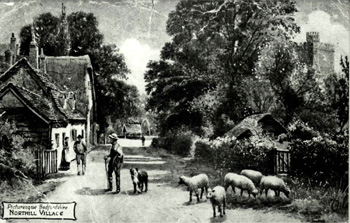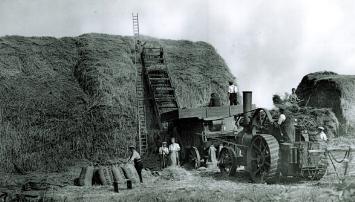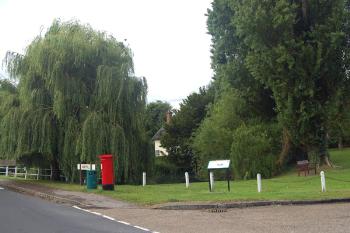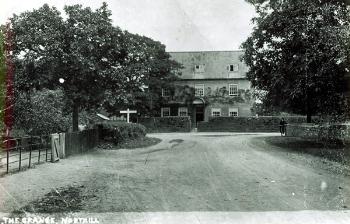Introduction

postcard of c.1900 [Z50/84/5]
Landscape
Northill is a large parish of some 4,140 acres and includes the settlements of Budna, Hatch, Ickwell, Lower Caldecote, Thorncote Green and Upper Caldecote as well as the village of Northill itself. The parish contains a feeder stream to the River Ivel, which forms the eastern boundary of the parish. The land is low lying, only 205 feet above sea level at its highest point (in the west) dropping to a low point of 74 feet in the north. The soil is clay and gravel, as might be expected in the vicinity of a river.

The threshing process at Northill in 1939 [Z50/84/77]
Name
Northill is first recorded, as Nortgiuele and Nortgible, in the Domesday Book of 1086. Early forms of the name make in clear that the meaning is not "north hill" but "north Ivel". Other forms of the name recorded are: Northgille (1185); Norttgifelle (C13th); Northgiuele (1219-1294); Nortgylle (1242); Nortgiuel (1247); Northgevle (1271); Northyeuil (1287); Northyevele (1290-1387); Nortgewele (C13th); Nortgivill (C13th); Northyvele (1303-1364); Northevele (1346); Norrell (1443): Northyevyll (1470: Northyell (1494); Northewell (1526); Norryel (1535): Northyell (1535); Northiell (1536); Norrihill (1537); Norhill (1675).

Northill Pond Jul 2007
Domesday
Northill lay in the Hundred of Wixamtree and the principal landowner in Northill in 1086 was William Speke. He held six and a half hides as a manor, which included ten villagers, four slaves, half a mill and woodland for two hundred pigs. The manor had been worth £8 in 1066, declining to £6 when Speke acquired it, probably as a result of the depredations of William I's army as it moved north. The value in 1086 remained at £6. Before the Conquest the land had been held collectively by six freemen.
Eudo, son of Hubert was also an important landowner in Northill in 1086. He held three hides in the parish. One and a half hides were tenanted by a man called Pirot. The holding included three villagers and a smallholder and also included a mill. It had been worth 25 shillings in 1066, when it had been held by one Raven, declining to 10 shillings when Eudo acquired it. By 1086 the value had risen to 20 shillings (£1). Eudo held a further one and a half hides in Northill, the tenant of these being one Ralph. This holding included five smallholders and three slaves as well as woodland for a hundred pigs. It had been worth £3 in 1066, when it had been held by two freemen, declining to £2 when Eudo acquired it, but had again risen to £3 by 1086.
Another half hide was held by Hugh de Beauchamp, later created Baron of Bedford. His tenant was a man called Walter. This holding had been worth 10 shillings in 1066, declining to 5/- by the time Hugh acquired it and remaining at that valuation in 1086. The land had been held from the king by a man called Osgeat in 1066.

The Grange c.1900 [Z50/84/3]
Manors
Northill Manor
William Speke's manor became known as Northill Manor and remained in his family until 1183 when it passed to his sister Albreda, wife of Nicholas de Trailly. Two years later it was held by Mary, widow of Geoffrey de Trailly. By 1248 it was held by William de la Zouche, the second husband of Maud, widow of John de Trailly but the de Traillys were still overlords. It passed out of the family in 1401 when it was alienated to Sir Gerard Braybrooke and others, though Reginald de Trailly retained one acre so that he could still call himself the king's tenant. Braybrooke seems to have alienated the manor quite quickly to John de Meppershall as, in 1428, it was held by the husband of his daughter, Joan, one Henry Godfrey. On the death of Richard Godfrey his property in Northill was divided amongst his daughters as co-heirs. The manor passed to the Harding family, Richard being in possession in 1584. His granddaughter became owner of the manor and married Edward Kent in 1624. The next reference is in 1652 when Thomas Ellis conveyed the manor to Thomas Bromsall, remaining in that family until the next century when it passed to the Robinson family of Denston Hall, Suffolk. John Robinson sold his Bedfordshire estates, by act of parliament, in 1802 when John Harvey of Ickwell Bury purchased the manor, which stayed with the family into the 20th century (all manorial incidents, courts and tenure of land being abolished under the Law of Property Act 1922.).
Manor of Northill College
A second manor based around the village of Northill is first mentioned in the fourteenth century - the Manor of Northill College, the first known lord being the parson Roger de Lameleye (rector from 1330 to 1346), claiming his predecessors had owned these since time immemorial. The parish church became collegiate in 1404 and the manor was appropriated to support the college. Land in Beeston (Sandy parish) was added to the manor in 1519 but the college was disbanded during Henry VIII's Dissolution of the Monasteries at which time the manor passed to the Crown and was granted in 1549 to Sir William Fitz William. On the death of his widow in 1575 the manor was divided between Sir Thomas Browne, husband of a daughter of William Fitz William, and Fitz William's other three daughters. Browne bought two of these shares in 1577 and 1580 respectively and his son Richard inherited the last when its owner died childless in 1597. The manor was sold in 1610 to Edward Osborne though at some point it ceased to be considered a manor as the will of Edward Osborne's son, Edward, who died in 1679 devised his property in Northill without naming a manor.
Population
Northill has always been a reasonably populated parish, mainly because of the presence of so many hamlets. At the time of the Domesday Book 26 villagers, smallholders and slaves are noted; this figure should be multiplied by at least four to allow for these men's dependents - giving a total population of something over a hundred - a decent sized parish for the date. The population figures for the parish were reasonably static for over a century, the total in 1841 being 1,280 and in 1951 1,298. In the next half century the population grew to nearly double. The figures do not give a breakdown between the various settlements but the greatest growth has undoubtedly been in the size of Upper Caldecote.
1801: 715 1851: 1,364 1901: 1,348 1951: 1,298 2001: 2,284